Kevin A. Smith
Counterfactual World Modeling for Physical Dynamics Understanding
Dec 26, 2023



Abstract:The ability to understand physical dynamics is essential to learning agents acting in the world. This paper presents Counterfactual World Modeling (CWM), a candidate pure vision foundational model for physical dynamics understanding. CWM consists of three basic concepts. First, we propose a simple and powerful temporally-factored masking policy for masked prediction of video data, which encourages the model to learn disentangled representations of scene appearance and dynamics. Second, as a result of the factoring, CWM is capable of generating counterfactual next-frame predictions by manipulating a few patch embeddings to exert meaningful control over scene dynamics. Third, the counterfactual modeling capability enables the design of counterfactual queries to extract vision structures similar to keypoints, optical flows, and segmentations, which are useful for dynamics understanding. We show that zero-shot readouts of these structures extracted by the counterfactual queries attain competitive performance to prior methods on real-world datasets. Finally, we demonstrate that CWM achieves state-of-the-art performance on the challenging Physion benchmark for evaluating physical dynamics understanding.
Physion++: Evaluating Physical Scene Understanding that Requires Online Inference of Different Physical Properties
Jun 27, 2023Abstract:General physical scene understanding requires more than simply localizing and recognizing objects -- it requires knowledge that objects can have different latent properties (e.g., mass or elasticity), and that those properties affect the outcome of physical events. While there has been great progress in physical and video prediction models in recent years, benchmarks to test their performance typically do not require an understanding that objects have individual physical properties, or at best test only those properties that are directly observable (e.g., size or color). This work proposes a novel dataset and benchmark, termed Physion++, that rigorously evaluates visual physical prediction in artificial systems under circumstances where those predictions rely on accurate estimates of the latent physical properties of objects in the scene. Specifically, we test scenarios where accurate prediction relies on estimates of properties such as mass, friction, elasticity, and deformability, and where the values of those properties can only be inferred by observing how objects move and interact with other objects or fluids. We evaluate the performance of a number of state-of-the-art prediction models that span a variety of levels of learning vs. built-in knowledge, and compare that performance to a set of human predictions. We find that models that have been trained using standard regimes and datasets do not spontaneously learn to make inferences about latent properties, but also that models that encode objectness and physical states tend to make better predictions. However, there is still a huge gap between all models and human performance, and all models' predictions correlate poorly with those made by humans, suggesting that no state-of-the-art model is learning to make physical predictions in a human-like way. Project page: https://dingmyu.github.io/physion_v2/
H-SAUR: Hypothesize, Simulate, Act, Update, and Repeat for Understanding Object Articulations from Interactions
Oct 22, 2022



Abstract:The world is filled with articulated objects that are difficult to determine how to use from vision alone, e.g., a door might open inwards or outwards. Humans handle these objects with strategic trial-and-error: first pushing a door then pulling if that doesn't work. We enable these capabilities in autonomous agents by proposing "Hypothesize, Simulate, Act, Update, and Repeat" (H-SAUR), a probabilistic generative framework that simultaneously generates a distribution of hypotheses about how objects articulate given input observations, captures certainty over hypotheses over time, and infer plausible actions for exploration and goal-conditioned manipulation. We compare our model with existing work in manipulating objects after a handful of exploration actions, on the PartNet-Mobility dataset. We further propose a novel PuzzleBoxes benchmark that contains locked boxes that require multiple steps to solve. We show that the proposed model significantly outperforms the current state-of-the-art articulated object manipulation framework, despite using zero training data. We further improve the test-time efficiency of H-SAUR by integrating a learned prior from learning-based vision models.
AGENT: A Benchmark for Core Psychological Reasoning
Feb 25, 2021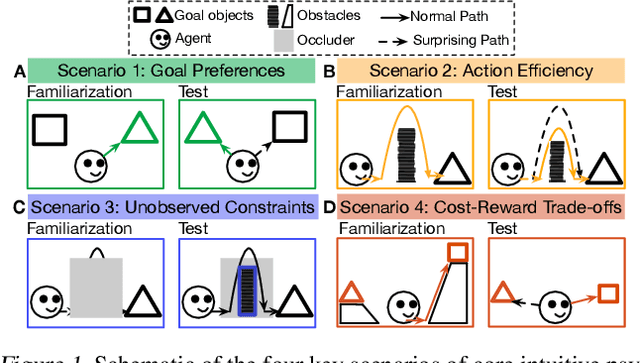

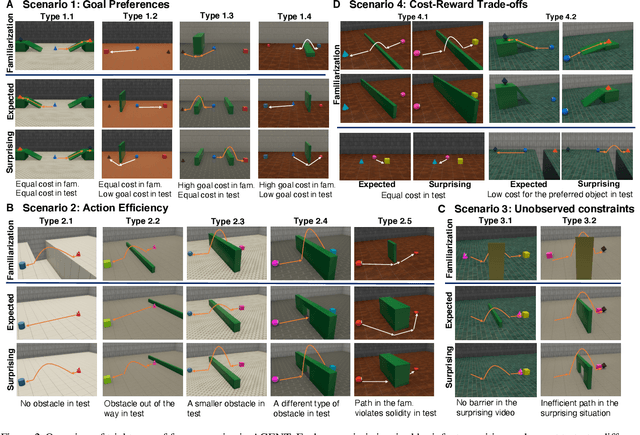
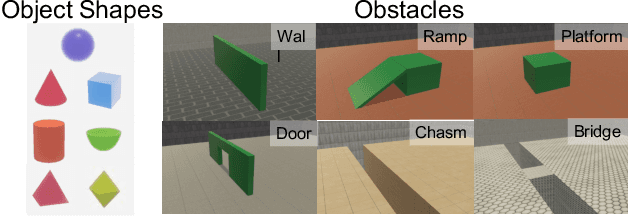
Abstract:For machine agents to successfully interact with humans in real-world settings, they will need to develop an understanding of human mental life. Intuitive psychology, the ability to reason about hidden mental variables that drive observable actions, comes naturally to people: even pre-verbal infants can tell agents from objects, expecting agents to act efficiently to achieve goals given constraints. Despite recent interest in machine agents that reason about other agents, it is not clear if such agents learn or hold the core psychology principles that drive human reasoning. Inspired by cognitive development studies on intuitive psychology, we present a benchmark consisting of a large dataset of procedurally generated 3D animations, AGENT (Action, Goal, Efficiency, coNstraint, uTility), structured around four scenarios (goal preferences, action efficiency, unobserved constraints, and cost-reward trade-offs) that probe key concepts of core intuitive psychology. We validate AGENT with human-ratings, propose an evaluation protocol emphasizing generalization, and compare two strong baselines built on Bayesian inverse planning and a Theory of Mind neural network. Our results suggest that to pass the designed tests of core intuitive psychology at human levels, a model must acquire or have built-in representations of how agents plan, combining utility computations and core knowledge of objects and physics.
Towards Human-Level Learning of Complex Physical Puzzles
Nov 14, 2020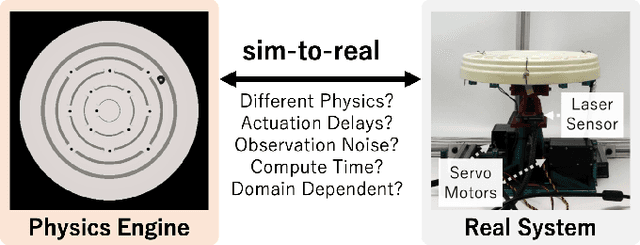

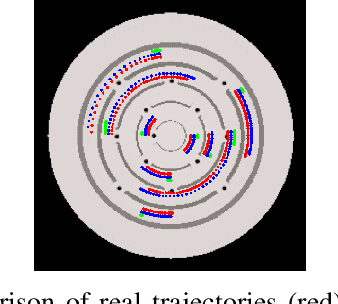
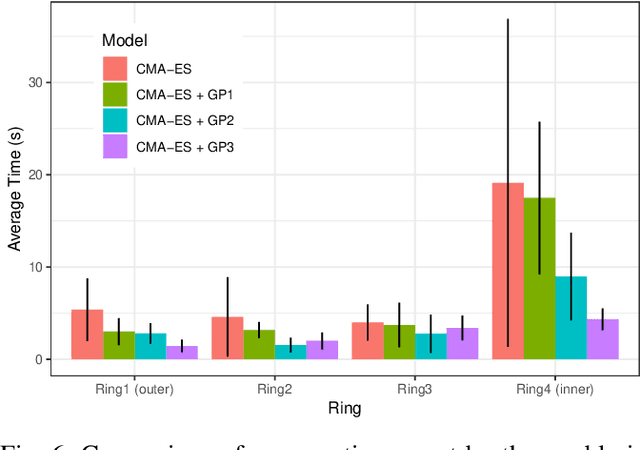
Abstract:Humans quickly solve tasks in novel systems with complex dynamics, without requiring much interaction. While deep reinforcement learning algorithms have achieved tremendous success in many complex tasks, these algorithms need a large number of samples to learn meaningful policies. In this paper, we present a task for navigating a marble to the center of a circular maze. While this system is very intuitive and easy for humans to solve, it can be very difficult and inefficient for standard reinforcement learning algorithms to learn meaningful policies. We present a model that learns to move a marble in the complex environment within minutes of interacting with the real system. Learning consists of initializing a physics engine with parameters estimated using data from the real system. The error in the physics engine is then corrected using Gaussian process regression, which is used to model the residual between real observations and physics engine simulations. The physics engine equipped with the residual model is then used to control the marble in the maze environment using a model-predictive feedback over a receding horizon. We contrast the learning behavior against the time taken by humans to solve the problem to show comparable behavior. To the best of our knowledge, this is the first time that a hybrid model consisting of a full physics engine along with a statistical function approximator has been used to control a complex physical system in real-time using nonlinear model-predictive control (NMPC). Codes for the simulation environment can be downloaded here https://www.merl.com/research/license/CME . A video describing our method could be found here https://youtu.be/xaxNCXBovpc .
The Tools Challenge: Rapid Trial-and-Error Learning in Physical Problem Solving
Jul 25, 2019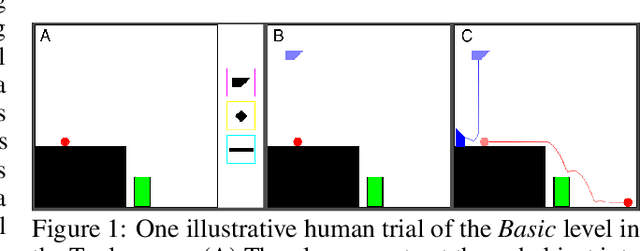

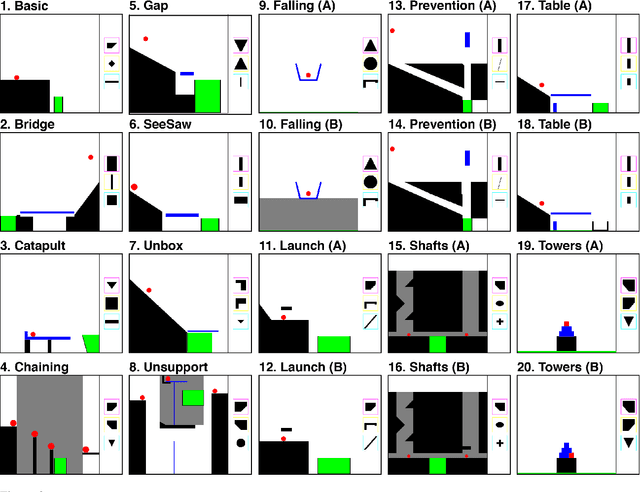
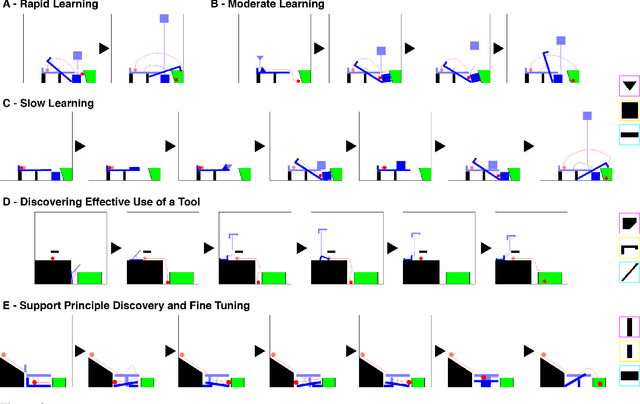
Abstract:Many animals, and an increasing number of artificial agents, display sophisticated capabilities to perceive and manipulate objects. But human beings remain distinctive in their capacity for flexible, creative tool use -- using objects in new ways to act on the world, achieve a goal, or solve a problem. Here we introduce the "Tools" game, a simple but challenging domain for studying this behavior in human and artificial agents. Players place objects in a dynamic scene to accomplish a goal that can only be achieved if those objects interact with other scene elements in appropriate ways: for instance, launching, blocking, supporting or tipping them. Only a few attempts are permitted, requiring rapid trial-and-error learning if a solution is not found at first. We propose a "Sample, Simulate, Update" (SSUP) framework for modeling how people solve these challenges, based on exploiting rich world knowledge to sample actions that would lead to successful outcomes, simulate candidate actions before trying them out, and update beliefs about which tools and actions are best in a rapid learning loop. SSUP captures human performance well across 20 levels of the Tools game, and fits significantly better than alternate accounts based on deep reinforcement learning or learning the simulator parameters online. We discuss how the Tools challenge might guide the development of better physical reasoning agents in AI, as well as better accounts of human physical reasoning and tool use.
 Add to Chrome
Add to Chrome Add to Firefox
Add to Firefox Add to Edge
Add to Edge